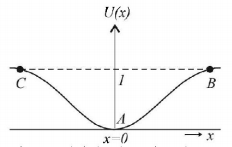161. The maximum velocity of a particle, executing simple harmonic motion with an amplitude $$7\,mm,$$ is $$4.4\,m/s.$$ The period of oscillation is
A
$$0.01\,s$$
B
$$10\,s$$
C
$$0.1\,s$$
D
$$100\,s$$
Answer :
$$0.01\,s$$
162. A particle free to move along the $$x$$-axis has potential energy given by $$U\left( x \right) = k\left[ {1 - \exp \left( { - {x^2}} \right)} \right]$$ for $$ - \infty \leqslant x \leqslant + \infty ,$$ where $$k$$ is a positive constant of appropriate dimensions. Then
A
at points away from the origin, the particle is in unstable equilibrium
B
for any finite nonzero value of $$x,$$ there is a force directed away from the origin
C
if its total mechanical energy is $$\frac{k}{2},$$ it has its minimum kinetic
energy at the origin.
D
for small displacements from $$x = 0,$$ the motion is simple harmonic
Answer :
for small displacements from $$x = 0,$$ the motion is simple harmonic
163.
A particle moving along the $$X$$-axis executes simple harmonic motion, then the force acting on it is given by
where, $$A$$ and $$K$$ are positive constants.
A
$$ - AKx$$
B
$$A\cos Kx$$
C
$$A\exp \left( { - K} \right)$$
D
$$AKx$$
Answer :
$$ - AKx$$
164.
A pendulum made of a uniform wire of cross sectional area $$A$$ has time period $$T$$. When an additional mass $$M$$ is added to its bob, the time period changes to $${T_M.}$$ If the Young's modulus of the material of the wire is $$Y$$ then $$\frac{1}{Y}$$ is equal to:
($$g$$ = gravitational acceleration)
A
$$\left[ {1 - {{\left( {\frac{{{T_M}}}{T}} \right)}^2}} \right]\frac{A}{{Mg}}$$
B
$$\left[ {1 - {{\left( {\frac{T}{{{T_M}}}} \right)}^2}} \right]\frac{A}{{Mg}}$$
C
$$\left[ {{{\left( {\frac{{{T_M}}}{T}} \right)}^2} - 1} \right]\frac{A}{{Mg}}$$
D
$$\left[ {1 - {{\left( {\frac{{{T_M}}}{T}} \right)}^2}} \right]\frac{{Mg}}{A}$$
Answer :
$$\left[ {{{\left( {\frac{{{T_M}}}{T}} \right)}^2} - 1} \right]\frac{A}{{Mg}}$$
165. A linear harmonic oscillator of force constant $$2 \times {10^6}\,N/m$$ and amplitude $$0.01\,m$$ has a total mechanical energy of $$160\,J.$$ Its
A
potential energy is $$160\,J$$
B
potential energy is $$100\,J$$
C
potential energy is zero
D
potential energy is $$120\,J$$
Answer :
potential energy is $$100\,J$$
166. A simple harmonic oscillator of angular frequency $$2\,rad\,{s^{ - 1}}$$ is acted upon by an external force $$F = \sin tN.$$ If the oscillator is at rest in its equilibrium position at $$t = 0,$$ its position at later times is given by :
A
$$\sin t + \frac{1}{2}\cos 2t$$
B
$$\cos t - \frac{1}{2}\sin 2t$$
C
$$\sin t - \frac{1}{2}\sin 2t$$
D
$$\sin t + \frac{1}{2}\sin 2t$$
Answer :
$$\sin t - \frac{1}{2}\sin 2t$$
167.
A particle is subjected to two mutually perpendicular simple harmonic motions such that its $$x = 2\sin \omega t,y = 2\sin \left( {\omega t + \frac{\pi }{4}} \right)$$
The path of the particle will be
A
a straight line
B
a circle
C
an ellipse
D
a parabola
Answer :
an ellipse
168.
A simple pendulum has time period $${T_1}.$$ The point of suspension is now moved upward according to the relation $$y = K{t^2},\left( {K = 1m/{s^2}} \right)$$ where $$y$$ is the vertical displacement. The time period now becomes $${T_2.}$$ The ratio of $$\frac{{T_1^2}}{{T_2^2}}$$ is
$$\left( {g = 10m/{s^2}} \right)$$
A
$$\frac{5}{6}$$
B
$$\frac{6}{5}$$
C
$$1$$
D
$$\frac{4}{5}$$
Answer :
$$\frac{5}{6}$$
169. A child swinging on a swing in sitting position, stands up, then the time period of the swing will
A
increase
B
decrease
C
remains same
D
increases of the child is long and decreases if the child is short
Answer :
decrease
170. Two simple harmonic motions with the same frequency act on a particle at right angles i.e. along $$X$$-axis and $$Y$$-axis. If the two amplitudes are equal and the phase difference is $$\frac{\pi }{2},$$ the resultant motion will be
A
a circle
B
an ellipse with the major axis along $$Y$$-axis
C
an ellipse with the major axis along $$X$$-axis
D
a straight line inclined at $${45^ \circ }$$ to the $$X$$-axis
Answer :
a circle
